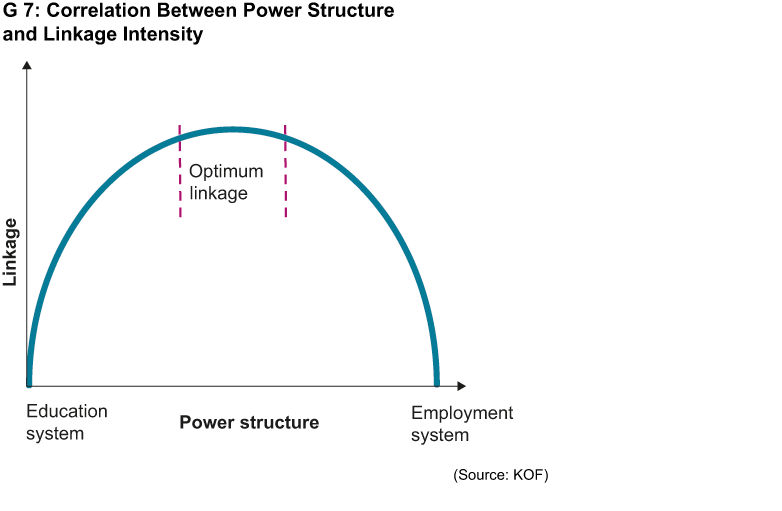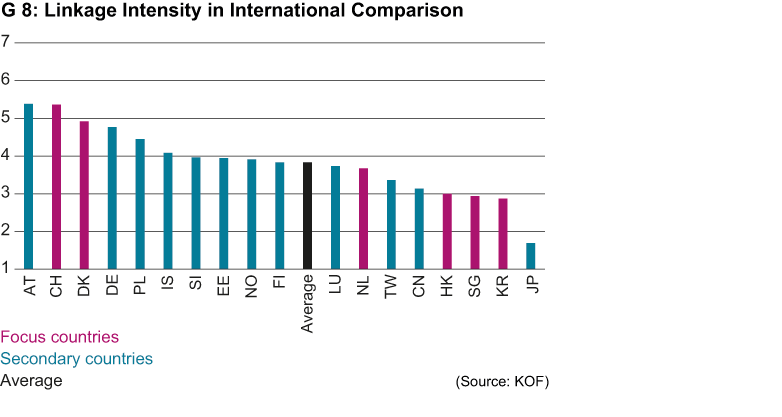Interaction Between Education and Employment: The KOF Education-Employment Linkage Index
- Education
- KOF Bulletin
Interaction between key actors in the labour and the education system is a crucial factor in determining the success of an economy. Up until now, this has been more of an assumption than an empirically substantiated thesis. KOF has now investigated the strength of the link between actors in the two systems in the form of an international comparative study.

Again and again we hear that interaction between actors in the education system on the one hand and the employment system on the other is an important prerequisite to ensure that vocational training for adolescents actually improves their labour market situation. This is surprising given the dearth of evidence that supports this hypothesis. A key reason for this is the vagueness of the concept of interaction between actors in the labour market and the vocational training system and how such linkage can be measured.
This article presents an approach that develops a theoretical concept of interaction between actors in the employment and the education system and measures linkage intensity on the basis of a survey conducted among experts in 20 different countries. The selection of the countries was based on the world’s most successful education systems, which were subsequently divided into two groups. The first consists of the ten countries that achieved the best PISA results.
This follows the hypothesis that good basic knowledge at the end of compulsory schooling is a necessary requirement for advanced education leading to the labour market. The second group consists of the ten countries that are achieving the best results in terms of the youth labour market. In this case, it has been assumed that good results on the youth labour market are based on solid vocational training.
Measuring linkage intensity along the education process
Linkage intensity, i.e. the intensity of communication between actors in the education and the employment system, can be interpreted as a function of the ‘power’ actors in the education and the employment system exercise on the education process (see G 7). Where actors in the education system are exclusively responsible for vocational training, the skills acquired during training generally fail to coincide with the skills required on the labour market. If, in contrast, actors in the employment system hold all the power, the imparted skills will be too company-specific and will not be recognised by the education system. Consequently, they will not lead to advanced education. Linkage intensity is highest when actors in both systems share power, leading to optimised communication and the teaching of employable skills as well as to advanced education.
To measure linkage intensity in vocational education and training, several processes must be identified during which actors in the education and the employment system communicate with each other: As a first step, the Curriculum Value Chain concept is applied, which breaks the education process down into three phases in which linkage is relevant.
The first phase, the curriculum design phase, consists of defining the curriculum including, for instance, exam design and the skills to be imparted. The actual training takes place in the second phase, the curriculum application phase. At this stage, relevant factors include, for instance, the teaching locations involved in implementing the curriculum, i.e. exclusively school-based training or inclusion of labour market locations. This phase delivers observable results in the labour market, taking the form of outcomes, which are evaluated during the curriculum feedback phase and integrated as findings into the curriculum design and application phases. Based on this concept, specific sub-processes are identified in each phase during which actors in the education and the employment system communicate with each other. As a last step, the relevant characteristics of each process are identified in order to describe the linkage intensity in each of the processes.
On the basis of this detailed description of characteristics, a questionnaire was developed and sent out to vocational experts in the selected 20 countries. Aside from experts in the education system, the survey also included vocational education experts in the employment system and in research. Among the 20 countries, six focus countries were selected, in which an average of 20 experts were surveyed and detailed case studies were conducted. In the remaining 14 countries, one or two experts were surveyed. The results may therefore not be entirely significant. Experts willing to participate in the survey could not be found either in Canada or Lithuania. In Switzerland, replies were received from 59 experts, which represents a return rate of 57 per cent. 39 per cent of the experts are active in the education system, 53 per cent in the employment system and eight per cent in research.
Graph G 8 presents the results of the KOF Education-Employment Linkage Index (KOF EELI). Focus countries are shown in red, secondary countries in blue and the average in black. The results in terms of aggregated linkage intensity show that Austria comes out top, although only one observation was made. Linkage intensity is not much lower in Switzerland, followed by Denmark and Germany - all three countries have a well-established dual vocational training system. In contrast, countries in South-East Asia which have particularly high PISA results, such as Hong Kong, Singapore, South Korea or Japan, are at the bottom of the linkage intensity scale.
In summary, the KOF EELI has brought to light interesting results not only in regard to linkage intensity in the various sub-processes but also in respect of their characteristics. These results should kick off an evidence-based debate on strategic vocational training reforms. In specific, the results allow for the identification of strengths and weaknesses of vocational training programmes and help derive potential strategies for improvement.
Note on KOF EELI:
The KOF Education-Employment Linkage Index (KOF EELI) was developed in the context of a feasibility study on behalf of the Center on International Education Benchmarking (Washington, USA). In the coming years, the scientific base will be enlarged and the number of surveyed countries extended to allow for the development of an effective benchmark.
Contact
No database information available
Contact
No database information available


